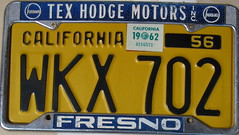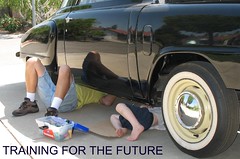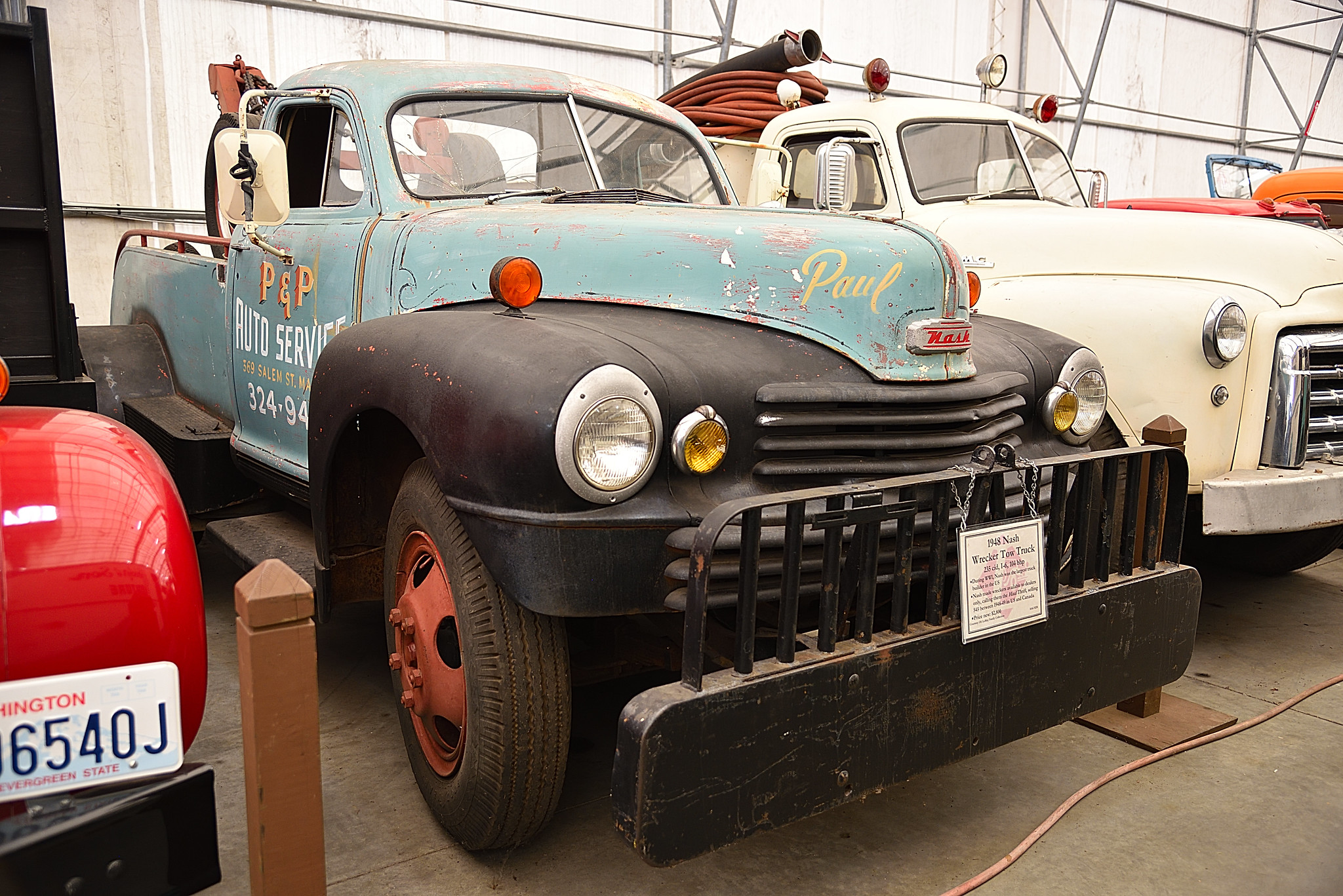Announcement
Collapse
No announcement yet.
Studebake Cab on Nash Wrecker
Collapse
X
-
Never seen that one, but my neighbor two doors up has a Nash wrecker with an International/Diamond-T/Reo cab; maybe a couple of years later. What was the year listed for the one with the Stude cab?
jack vines
1948 Nash Tow Truck - John Gunnell
A 1948 Nash factory-built wrecker is only one of the many rarities to be found at the Wisconsin Automotive Museum in Hartford, WI. The hard-to-find hauler joins other unique attractions in a museum that focuses on Nash, Kissel and AMC automobiles, all of which were made in Wisconsin. It is also the home of the Southeast Wisconsin Short Track Racing Hall of Fame.
The truck borrows the front end sheet metal of the postwar Nash Ambassador.
The Nash “Haul-Thrift” truck was destined to become a machine that you didn’t see every day. From 1947 to 1954, Nash built only 4,998 of them. They came in two similar models: the 3148 with a 133-inch wheelbase and the 3248 with a 157-inch wheelbase.
Nash trucks were made primarily for export to other countries. However, Nash dealerships in the United States could each order one of them to use as a tow truck. What could be cooler than having a tow truck of the same brand as the cars you serviced and sold?
Both Nash trucks were powered by the company’s reliable 234.8-cid overhead valve in-line six-cylinder engine. It produced 104 hp at 3400 rpm and drove through a four-speed gearbox. A five-speed and a Timken double-reduction hypoid vacuum-shift rear axle that increased the number of forward “gears” to eight were available at additional cost.
The Nash trucks—both models—had 14,000-pound GVW ratings with the standard axle or 15,500 pound GVW ratings with an optional two-speed rear axle. Eight-ply 7.00 x 20 tires were standard equipment and 10-ply 8.25 x 20s could be ordered at extra cost.
The towing apparatus is so intact it looks like it could be used.
These Nash commercial vehicles had fancy styling for a truck. That’s because the body panels used for the fenders, hood, cab and instrument panel came from the Nash’s Ambassador, a rather luxurious passenger car. The Nash trucks’ radiator grilles also had simplified copies of the Ambassador’s grille. Brown vinyl upholstery was used to make the inside of the cab a little bit fancier than the average truck interior of that era.
Even the smaller truck’s wheelbase was a foot longer than that of the Ambassador car and its frame construction was strictly heavy-duty. Leaf springs with auxiliary helper springs were used all around. The front and single-speed rear axles were Timken-Detroit units and large Lockheed brakes supplied stopping power.
The Nash wrecker in the Hartford Museum was owned and operated by Metzler Sales of Oshkosh, WI, which was a Nash dealer and later sold AMC, Jeep and Renault cars. The truck is finished in white with blue fenders and a blue tow boomLast edited by PackardV8; 10-13-2017, 05:21 PM.PackardV8
-
Well, it's not a '49-up cab, the door window shape isn't right. And the slope and shape of the windshield doesn't look right for an M-Series cab. I'm not sure I see a Studebaker cab there. What am I missing?Originally posted by Hawkowner View PostThis is a rare truck they were only sold to Nash Dealers but had a Studebaker cab at least.
This truck in in museum in Murdo South Dakota. worth the $11 admit lots of other one of cars including Studebakers. Paul
Paul
Winston-Salem, NC
Visit The Studebaker Skytop Registry website at: www.studebakerskytop.com
Check out my YouTube channel here: https://www.youtube.com/user/r1lark
Comment
-
Well its a handsome truck. I thought the nash pickup cab had more slope to the roof than this one.
I did some more research and find that there were two cab styles used. The one like on this wrecker looks a lot like the Stude cab and the other one with the high back portion of the roof which looks like a modern freightliner cab with the aero shape for big trailers.Last edited by t walgamuth; 10-14-2017, 05:01 AM.Diesel loving, autocrossing, Coupe express loving, Grandpa Architect.
Comment
-
I'm betting that the cab and other sheet metal all came from the Budd stamping plant, same source as much of the M truck hardware.Gary Ash
Dartmouth, Mass.
'32 Indy car replica (in progress)
’41 Commander Land Cruiser
'48 M5
'65 Wagonaire Commander
'63 Wagonaire Standard
web site at http://www.studegarage.com
Comment
-
When I stirred up this hornets nest I made some the assumption that do to the low volume of truck made by Nash that the did not tool up to build this cab. The cab looks lime a 50s Stude medium duty cab.I completely forgot about The Bud company they built many of the cabs for trucks . The closest cab to the
Nash cab of that era would have been the REO at that time REO had not Merged with Diamond T that did not happen till 67. Diamond T was closely connected with IHC and ran their cabs which may have been Bud.
Bud built the Aluminum cab for the first 9500 models of the Class 8 GMC General up until about 1980.
I
Comment
-
Cool looking truck! That’s one serious push bumper out front!
Shame looks like it’s been sitting there a long time.sigpic1957 Packard Clipper Country Sedan
"There's nothing stronger than the heart of a volunteer"
Lt. Col. Jimmy Doolittle
"I have a great memory for forgetting things" Number 1 son, Lee Chan
Comment
-
Minor nitpick: All 49-64 Stude [edit: C-cab] trucks used the same basic cab, although the windshield became one-piece (in 1954) and the rear window became larger (in 1955). Other than that, the cabs are interchangeable. The larger trucks got front fenders with larger wheel openings, and that (and their greater ground clearance) makes them look bigger.Originally posted by Hawkowner View PostWhen I stirred up this hornets nest I made some the assumption that do to the low volume of truck made by Nash that the did not tool up to build this cab. The cab looks lime a 50s Stude medium duty cab.
The lack of a more modern cab (while GM, Ford, and Dodge went through 3 or 4 re-stylings) is widely regarded as one of the principal reasons for the steady decline in Studebaker's truck sales after 1951.Last edited by Skip Lackie; 10-16-2017, 12:46 PM.Skip Lackie
Comment
-
Skip - I guess that you are forgetting all of the Champ trucks when you state: "All 49-64 Stude trucks used the same basic cab..."Originally posted by Skip Lackie View PostMinor nitpick: All 49-64 Stude trucks used the same basic cab, although the windshield became one-piece (in 1954) and the rear window became larger (in 1955). Other than that, the cabs are interchangeable. The larger trucks got front fenders with larger wheel openings, and that (and their greater ground clearance) makes them look bigger.
The lack of a more modern cab (while GM, Ford, and Dodge went through 3 or 4 re-stylings) is widely regarded as one of the principal reasons for the steady decline in Studebaker's truck sales after 1951.Gary L.
Wappinger, NY
SDC member since 1968
Studebaker enthusiast much longer
Comment
-
Yup. Just like Studebaker did years later to create the Champ truck cab.Originally posted by kurtruk View PostThey didn't have to tool up much. The cab is the front half of all their cars, 42-48.RadioRoy, specializing in AM/FM conversions with auxiliary inputs for iPod/satellite/CD player. In the old car radio business since 1985.
10G-C1 - 51 Champion starlight coupe
4H-K5 - 53 Commander starliner hardtop
5H-D5 - 54 Commander Conestoga wagon
Comment






Comment